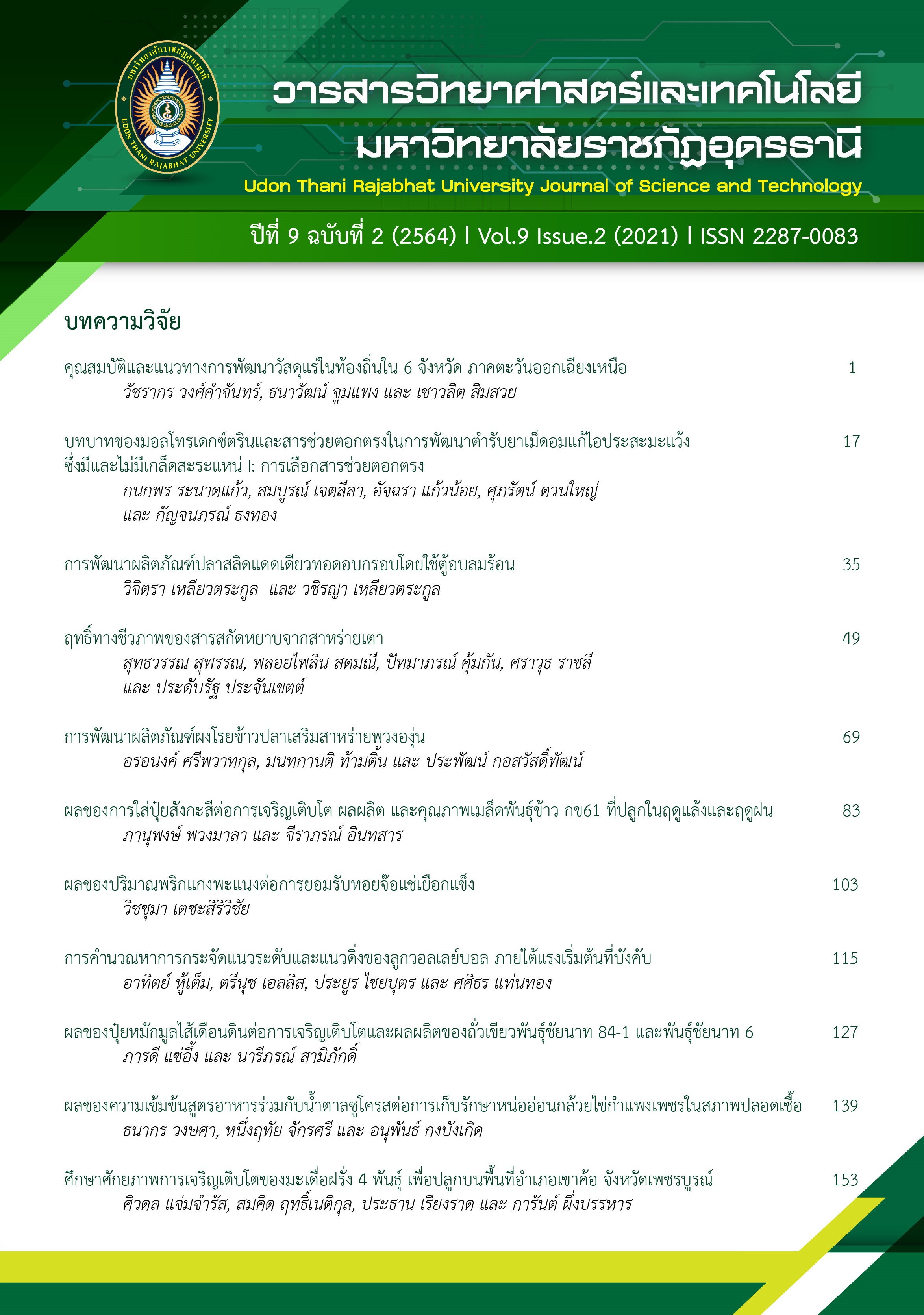EFFECT OF PANANG CURRY PASTE TOWARDS ACCEPTABILITY OF FROZEN HUI CHO
Main Article Content
Abstract
The objectives of this research were 1) to study the appropriate amount of Panang curry paste in Frozen Hui Cho, 2) to study the nutritional values of frozen Hui Cho, 3) to study the shelf-life, color, values and microorganism of frozen Hui Cho. The sensory quality was assessed for colour, smell, taste, texture and overall preference by 50 untrained panelists. The amount of Panang curry paste at 20% was the most preferred with the overall score at 7.98. There was a statistically significant difference (p<0.05). The most accepted frozen Hui Cho were fried and cooked. It was found that in the weight of 100 g/4 pieces, the nutritional values were as follows: total energy was at 162.88 kcal, 63.09 g of moisture content, 2.59 g of ash content, 5.12 g of fat content, 15.55 g of protein and 13.65 g of carbohydrates. The results of the research on shelf life, color quality and microorganisms revealed that after frying the frozen Hui Cho packed with polyethylene vacuum bags, stored at –18 °C for 12 weeks, it was found that the brightness L* was at 38.80, the red a* value was at 20.93, the yellow value b* was equal to 32.10 and a* was equal to 20.93 and b* was equal to 32.10. The total microbial count (Aerobic Plate Count) was not more than 1 × 106 CFU/g and no bacterial (Salmonella spp) growth was found under the Thai Industrial Standards 506/2555
Article Details
References
ญดา ศรีเงินยวง และ ชนิรัตน์ สำเร็จ. (2560). แกงไทย.กรุงเทพมหานคร: โรงพิมพ์พิมพ์ดี จำกัด.
ดวงกมล ตั้งสถิตพร, ดวงสุดา เตโชติรส, น้อมจิตต์ สุธีบุตร และ ชมภูนุช เผื่อนพิภพ. (2560). การพัฒนาผลิตภัณฑ์หมูยอทดแทนไขมันสัตว์ทอดกรอบ.รายงานผลการวิจัย,มหาวิทยาลัยเทคโนโลยีราชมงคลพระนคร
ปราณี อ่านเปรื่อง. (2547). หลักการวิเคราะห์ทางประสาทสัมผัส. กรุงเทพมหานคร: โรงพิมพ์แห่งจุฬาลงกรณ์มหาวิทยาลัย.
พรพาชื่น ชูเชิด, ชมพู่ ยิ้มโต และ ประดิษฐ์ หนองคำไผ่. (2550). การพัฒนาผลิตภัณฑ์หมูยอลดไขมันเสริมสมุนไพรแกงเขียวหวาน. รายงานผลการวิจัย, มหาวิทยาลัยเทคโนโลยีราชมงคลธัญบุรี.
ศรีสมร คงพันธุ์. (2551). เข้าครัวเป็นอาชีพ. พิมพ์ครั้งที่ 4. กรุงเทพมหานคร: สำนักพิมพ์แสงแดดจำกัด.
สถาบันอาหาร. (2564). เรื่องบริการตรวจวิเคราะห์. สืบค้นเมื่อวันที่ 18 กุมภาพันธ์ 2564, จาก https://www.nfi.or.th/service-chemical-analysis.php.
สาคร มะลิพันธุ์. (2554). อาหารว่าง. พิมพ์ครั้งที่ 3. กรุงเทพมหานคร: สำนักพิมพ์ หจก. ภาพพิมพ์.
สำนักงานมาตรฐานผลิตภัณฑ์อุตสาหกรรม. (2555). มาตรฐานผลิตภัณฑ์ชุมชนฮ่อยจ๊อมผช.506/2555. กรุงเทพมหานคร: กระทรวงอุตสาหกรรม.
สำนักพิมพ์แสงแดด. (2563). อาหารไทยจงเจริญ. กรุงเทพมหานคร: โรงพิมพ์พิมพ์ดี จำกัด.
สุภรณ์ พจนมณี. (2555). ตำรับอาหาร. พิมพ์ครั้งที่ 10. กรุงเทพมหานคร: วีรณาเพลส.
อรอนงค์ นัยวิกุล, วรรณี จิรภาคย์กุล, พิณทิพย์ รัมภกาภรณ์, ปรียา วิบูลย์เศรษฐ์, วราภา มหากาญจนกุล, สุดสาย ตรีวานิช, จิตศิริ ราชตนะพันธุ์, ปริศนา สุวรรณาภรณ์, ศิวาพร ศิวเวชช, อนุกูล วัฒนสุข, โชคชัย ธีรกุลเกียรติ, สายพิณ ทานัชฌาสัย, ทนง ภัครัชพันธุ์, ธนะบูลย์ สัจจาอนันตกุล, ศศิธร ตรงจิตภักดี, สายสนม ประดิษฐดวง, สงวนศรี เจริญศรี, วีรเชษฐ์ จิตตาณิชย์, สาวิตรี รัตนสุมาวงศ์, สุคนธ์ชื่น ศรีงาม, และ วรรณวิบูลย์ กาญจนกุญชร. (2559). วิทยาศาสตร์และเทคโนโลยีอาหารเล่ม 1. กรุงเทพมหานคร: สำนักพิมพ์มหาวิทยาลัยเกษตรศาสตร์.
James, C. S. (1995). Analytical Chemistry of Foods.Blackie Academic & Professional. London, pp 3-16.


